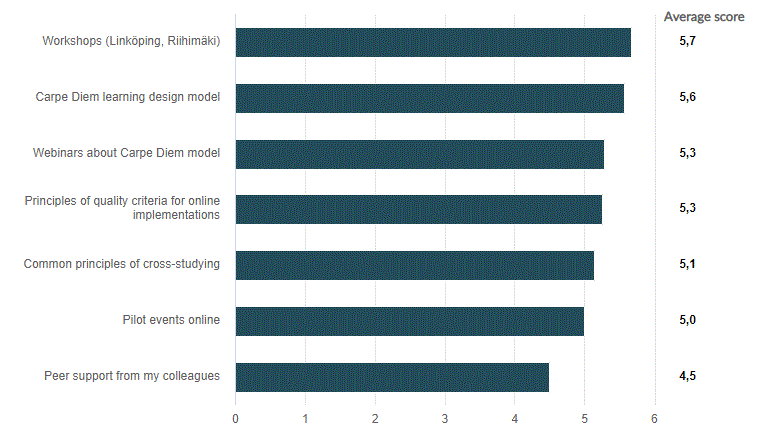
Jaana Kullaslahti
Finnish higher education institutions are urged to increase their international cooperation and create new activities for mobility. One way to internationalise is to design and offer online implementations with your partner universities. In the DIGILOG (digitally supported and virtual study practices for modern logistic systems) project, we created the online study module for cross-institutional studying.
DIGILOG is an international higher education development project funded by the Erasmus+ programme. The designed study module (15 credits) focuses on transportation management and the logistics of a multinational working environment considering digital decision support systems and simulation tools. One aim is to harmonise and renew the content and develop students’ and teachers’ internationalisation competence. (Kabashkin 2021).
We used the internationally well-known Carpe Diem online learning design model to support shared understanding during the planning and building of the module. The model is a cooperative, team-based approach to learning design and is suitable for designing or redesigning a course, module, unit, or programme. The idea behind Carpe Diem is competence-based and student-centred learning. (Salmon et al. 2020).
Learning design process: online webinars and face-to-face workshops
We applied the original six-step process (Salmon 2020) to seven online webinars and two face-to-face workshops. Between the meetings, teams worked with their modules (Table1) and prepared for the next webinar or workshop.
| Partner | Online study module/unit |
| TTK University of Applied Sciences, Estonia | Supply chain management simulation (3 credits) Effective warehouse design and process simulation (3 credits) |
| Transport and Telecommunication Institute, Latvia | Professional Competence of Transport Managers (3 credits) Game-based multi-criteria decision making for T&L competence development (3 credits) |
| Häme University of Applied Sciences, Finland | Passenger traffic railway markets are opening to competition, case of Finland (3 credits) |
| The Swedish National Road and Transport Research Institute | Train driving video-exercise for train dispatchers |
After the orientation webinar, the design teams first created a blueprint. It provides a general outline of the course, setting out goals and objectives, learning outcomes, and the manner of assessment. The second step was the face-to-face workshop. All the teams made a visual storyboard, representing the “student journey,” showing how learning and teaching processes are carried out. We also used the ABC learning design method (ABC LD 2020) and learning types card to idealise learning activities. Storyboard visits were very inspiring, walking around and looking at everyone else’s storyboards, sharing and getting ideas (Figure 1).

In the third step, design teams built their prototypes in the online environment, developing learning activities and digital materials. The theme of the second face-to-face workshop was reality checking: peer review and an action plan. The main idea was to get constructive peer feedback from colleagues and refine the design before piloting students’ online study modules. Moreover, we recommended the design teams request feedback from some students or colleagues at the university. Before the pilots, we asked the design teams to evaluate the module, in terms of how well it meets the ten most important quality criteria.
Principles for quality and cross-studying
What are the ten most important quality criteria? They are based on eAMK quality criteria (Varonen & Tyrväinen 2018), from which we selected essential ones and modified them suitably for our implementations. Three criteria of guidance and feedback, two of assignments and tools and one criterion concerning contents and materials, evaluation, usability and visuals. These criteria were used for peer reviewing and designing online study modules. The students’ feedback questionnaire during the pilots also included statements based on quality criteria.
Before the pilots, it was necessary to agree on principles for cross-institutional study like how to enrol and assess the implementations, and what kind of learning platforms and tools are being used. These principles are valuable for future cooperation.
Students’ and teachers’ experiences
We gathered students’ feedback during the pilots and the questionnaire based on the quality criteria. It included statements where students evaluate how well the quality criteria were implemented during the course and one open-ended question. The students experienced pilots and especially simulations to be very interesting, and the quality criteria come across quite well.
Teachers’ feedback about using the Carpe Diem methodology was very positive:
- a useful way of working
- the process was logical and well structured
- fits well with the goals of institutional cross-studying
- will help the study process and makes it visual for the students and teachers
- very interesting, universities should share their know-how, more cooperation
Teachers experienced all activities like workshops & webinars, pilot events, the Carpe Diem design model, quality criteria, and cross-studying principles, all of which are useful for designing an online study model (Figure 2).

We shared our online teaching and learning design expertise, subject and pedagogy competence during the Carpe Diem process. The model served as a framework for the whole project and new tools for teachers to design online learning. The process increases common understanding of online pedagogy and how to organize cross-institutional studying.
Author
Jaana Kullaslahti is Senior Specialist in Higher Education Pedagogy at HAMK Edu research unit.
References
Kabashkin, I., Grakovski, A., Segercrantz, W., Lend, E., Kallas, O., Karasmaa, N., Turunen, V., Sotanvalta, T., Tuukkanen, T., Kullaslahti, J., Thorslund, B & Olson, N. (2021) DIGILOG Project: Digitally Supported and Virtual Study Practices for Modern Logistic Systems. In: Kabashkin I., Yatskiv I., Prentkovskis O. (eds) Reliability and Statistics in Transportation and Communication. RelStat 2020, 14–17 October 2020, Riga, Latvia. Lecture Notes in Networks and Systems, vol 195. Springer, Cham, (p. 771–781). https://doi.org/10.1007/978-3-030-68476-1_71
Salmon, G., Van der Merwe, A. & Scoonwinkel A. (2020). A “watershed” for educational transformation: Deployment of carpe diem learning design methods in a South African context. Journal of Learning for Development, 7 (2), 127–141.
Salmon, G. (2020). Module Carpe Diem Learning Design: Preparation & Workshop. Handbook, version 19. https://www.gillysalmon.com/uploads/5/0/1/3/50133443/carpe_diem_planning_process_workbook_webversion1june2020.pdf
ABC LD. (2020). ABC LD Toolkit. https://abc-ld.org
Varonen, M. & Tyrväinen P. (2018). eAMK Quality Criteria for Online Implementations. In G. Ubachs & F. Joosten-Adriaanse (Eds.), Blended and Online Learning: “Changing the Educational Landscape”. Overview of papers on Higher Education for the Future as presented during the Online, Open and Flexible Higher Education Conference in Aarhus, October 2018 (p. 103–112). https://conference.eadtu.eu/download2468





